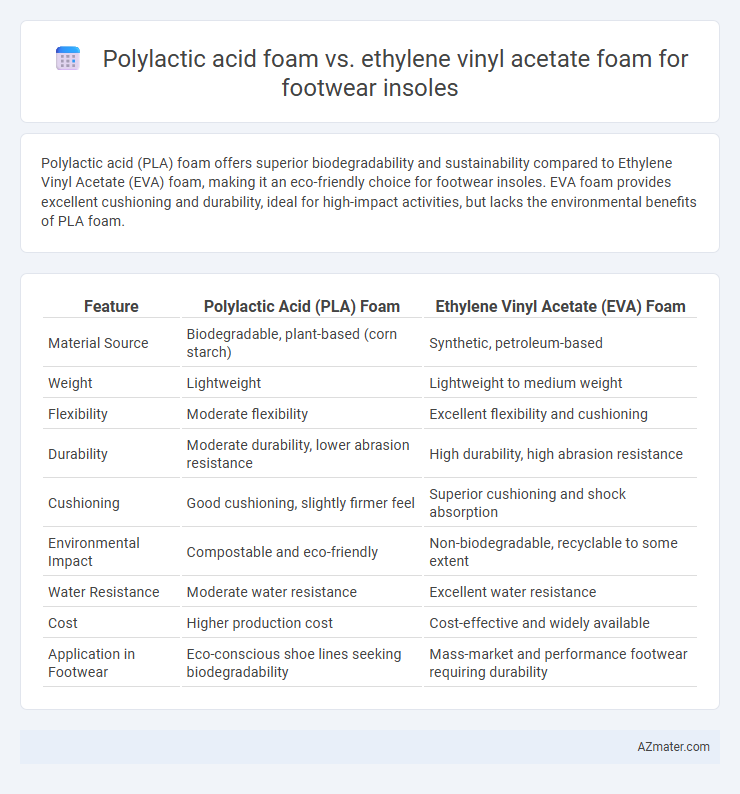Polylactic acid (PLA) foam offers superior biodegradability and sustainability compared to Ethylene Vinyl Acetate (EVA) foam, making it an eco-friendly choice for footwear insoles. EVA foam provides excellent cushioning and durability, ideal for high-impact activities, but lacks the environmental benefits of PLA foam.
Table of Comparison
| Feature | Polylactic Acid (PLA) Foam | Ethylene Vinyl Acetate (EVA) Foam |
|---|---|---|
| Material Source | Biodegradable, plant-based (corn starch) | Synthetic, petroleum-based |
| Weight | Lightweight | Lightweight to medium weight |
| Flexibility | Moderate flexibility | Excellent flexibility and cushioning |
| Durability | Moderate durability, lower abrasion resistance | High durability, high abrasion resistance |
| Cushioning | Good cushioning, slightly firmer feel | Superior cushioning and shock absorption |
| Environmental Impact | Compostable and eco-friendly | Non-biodegradable, recyclable to some extent |
| Water Resistance | Moderate water resistance | Excellent water resistance |
| Cost | Higher production cost | Cost-effective and widely available |
| Application in Footwear | Eco-conscious shoe lines seeking biodegradability | Mass-market and performance footwear requiring durability |
Introduction to Footwear Insole Materials
Polylactic acid (PLA) foam offers a biodegradable and sustainable alternative to traditional Ethylene Vinyl Acetate (EVA) foam, commonly used in footwear insoles for its cushioning and flexibility. EVA foam remains popular due to its excellent shock absorption, lightweight properties, and durability, making it a standard choice in athletic and casual footwear. Both materials provide unique benefits, with PLA foam aligning with eco-friendly trends while EVA foam delivers consistent comfort and performance in diverse footwear applications.
Overview of Polylactic Acid (PLA) Foam
Polylactic Acid (PLA) foam, derived from renewable resources like cornstarch, offers biodegradability and a lower environmental impact compared to conventional foams such as Ethylene Vinyl Acetate (EVA). PLA foam exhibits excellent cushioning, lightweight properties, and moisture resistance, making it suitable for eco-friendly footwear insoles. Its thermal insulation and shock absorption capabilities provide comfort and durability, aligning with sustainable manufacturing trends in the footwear industry.
Overview of Ethylene Vinyl Acetate (EVA) Foam
Ethylene Vinyl Acetate (EVA) foam is a popular choice for footwear insoles due to its excellent cushioning, flexibility, and shock absorption properties. Its closed-cell structure provides lightweight durability and resistance to compression set, making it ideal for high-impact activities and long-lasting comfort. EVA foam also offers good water resistance and can be easily molded, enhancing insole customization and overall foot support.
Comfort and Cushioning Comparison
Polylactic acid (PLA) foam offers superior breathability and moisture-wicking properties, providing enhanced comfort for footwear insoles by reducing sweat accumulation and odor. Ethylene vinyl acetate (EVA) foam excels in cushioning with its excellent shock absorption and flexibility, which supports prolonged wear and impact resistance. While PLA foam is biodegradable and eco-friendly, EVA foam remains preferred for high-performance cushioning and durability in athletic footwear insoles.
Durability and Longevity Analysis
Polylactic acid (PLA) foam offers biodegradability and decent cushioning but generally exhibits lower durability and faster wear under repeated stress compared to Ethylene vinyl acetate (EVA) foam, which is renowned for its superior abrasion resistance and flexibility. EVA foam maintains structural integrity over prolonged use, providing longer-lasting support and resilience crucial for high-impact footwear insoles. The longevity of EVA foam significantly outperforms PLA foam, making it more suitable for performance and everyday footwear applications where durability is a priority.
Environmental Impact and Biodegradability
Polylactic acid (PLA) foam offers significant environmental benefits for footwear insoles due to its renewable plant-based origin and superior biodegradability compared to Ethylene vinyl acetate (EVA) foam, which is petroleum-based and resists natural degradation. PLA foam decomposes fully under industrial composting conditions within months, reducing landfill accumulation and microplastic pollution, while EVA foam can persist for decades, contributing to long-term environmental harm. The use of PLA foam in insoles supports circular economy principles by enabling closed-loop recycling and lowering carbon emissions associated with production and disposal.
Manufacturing Process Differences
Polylactic acid (PLA) foam for footwear insoles is produced through a biodegradable polymerization process derived from renewable resources like corn starch, involving extrusion and controlled foaming using physical or chemical blowing agents. Ethylene vinyl acetate (EVA) foam manufacturing relies on copolymerization of ethylene and vinyl acetate monomers, followed by heat and pressure expansion techniques such as compression or injection molding to achieve its flexible cellular structure. The PLA process emphasizes sustainability and biodegradability, whereas EVA focuses on precise control of density and elasticity for performance footwear applications.
Cost Effectiveness and Market Availability
Polylactic acid (PLA) foam offers a sustainable and biodegradable alternative for footwear insoles but typically comes at a higher cost compared to Ethylene Vinyl Acetate (EVA) foam, which remains the industry standard due to its affordability and widespread availability. EVA foam provides excellent cushioning and durability at a lower price point, supporting mass-market production and distribution globally. Market availability favors EVA foam, with established supply chains and a broad range of formulations, while PLA foam is gaining traction primarily in niche eco-friendly segments despite limited large-scale manufacturing capacity.
Performance in Moisture and Heat Conditions
Polylactic acid (PLA) foam offers biodegradable advantages and moderate moisture resistance but tends to absorb more water, potentially compromising cushioning under high-humidity conditions. Ethylene vinyl acetate (EVA) foam exhibits superior moisture-wicking properties and maintains consistent elasticity and shock absorption even in elevated heat environments, making it more durable for prolonged use. EVA's greater thermal stability ensures better insole performance in hot climates, whereas PLA foam may degrade faster due to lower heat tolerance.
Future Trends in Sustainable Insole Materials
Polylactic acid (PLA) foam is gaining prominence as a biodegradable and compostable alternative to traditional Ethylene Vinyl Acetate (EVA) foam in sustainable footwear insole production. Advances in PLA foam technology aim to enhance cushioning performance and durability while reducing environmental impact through renewable resources and lower carbon footprint manufacturing processes. Future trends emphasize hybrid materials combining PLA with bio-based EVA derivatives to optimize comfort, recyclability, and biodegradability in eco-friendly insoles.

Infographic: Polylactic acid foam vs Ethylene vinyl acetate foam for Footwear insole
 azmater.com
azmater.com